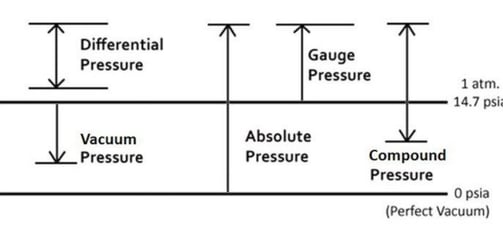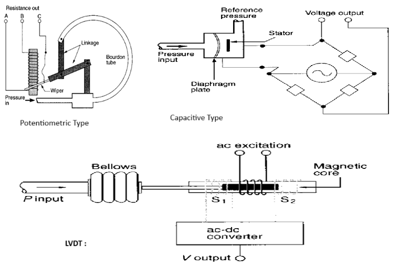Pressure
Pressure :
Types of Pressure measurements
Absolute Pressure
Gauge Pressure
Differential Pressure
Vacuum Pressure
Absolute Pressure :
The total pressure that a fluid exerts, including atmospheric pressure and any other pressure, is known as absolute pressure.
It is measured in relation to zero pressure, or a perfect vacuum.
Absolute pressure cannot have a negative value since it uses absolute zero pressure as a reference.
Gauge Pressure :
The pressure in relation to the ambient atmospheric pressure is known as the gauge pressure.
It could be either positive or negative. Negative gauge pressure, sometimes referred to as vacuum pressure, indicates a pressure lower than atmospheric, whereas positive gauge pressure indicates a pressure higher than atmospheric.
Differential Pressure :
The difference between two pressure readings is known as differential pressure.
It is the difference between two pressure points rather than a pressure in and of itself.
Atmospheric Pressure : it is also known as Barometric pressure
the force that the earth's atmosphere exerts. At sea level, the atmospheric pressure is 14.696 psia. As altitude increases, the atmospheric pressure value falls.


Types of Pressure sensors
Bourdon tube sensor : its available in "C: shape , Helical Shape and Spiral Shape tube.
Diaphragm Pressure sensor : Single type and Capsule type Diaphragms
Bellow Pressure sensor
Vacuum Pressure
Pressure transducer is a device that transforms a pressure sensor's mechanical output into a conventional electrical output. usually resistance or voltage.
Potentiometers are variable resistors used in potentiometric pressure transducers. Resistance wire is wound around an insulated cylinder to create it. On each turn, a wiper a movable electrical contact touches the wire once as it moves along the cylinder. The amount of resistance between the wiper and the wire end depends on the wiper's position.


What is Pressure : One force acting against another is called pressure. Force applied to or dispersed across a surface is called pressure.
P = F/A is the formula for the pressure P of a force F distributed over an area A.


